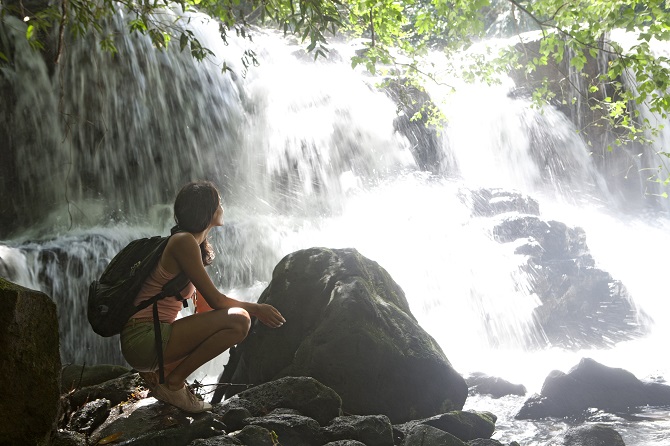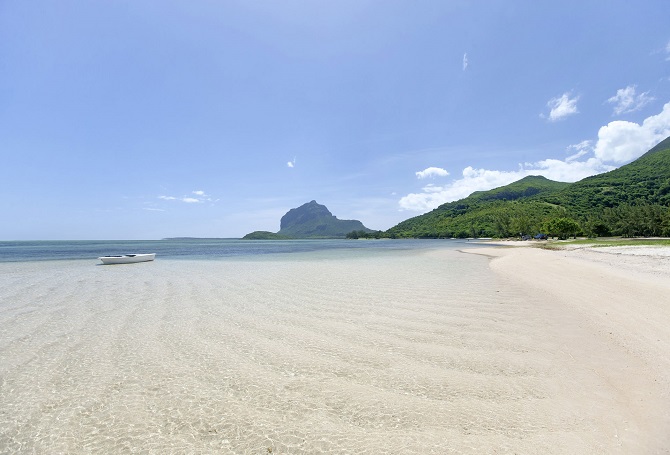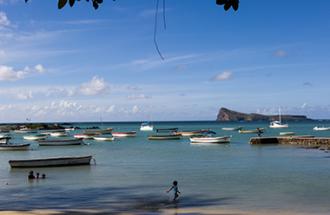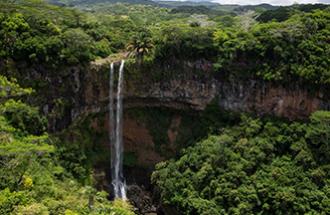The South & South-East
The West & South-West
The wildest and most beautiful landscapes of the island are in the South: sandy beaches bordered by cliffs carved by waves, rocky shores, sugar cane fields as far as the eye can see, and mountainous terrains offering magnificent panoramas. The integrated tourist area of Bel Ombre is also a model of its kind.
What to See?
Mahebourg
One of the main fishing villages on the island, Mahebourg is built along the shore of the immense bay of Grand Port. Founded in 1804 by the French Governor Charles Decaen, Mahebourg witnessed the only Napoleonic naval victory over the English in 1810. This victory is also listed on the Arc de Triomphe in Paris. A major centre of economic life under French administration, Mahebourg was also known for its slave market.
Full of emotions, it is one of the rare places on the island that has kept this particular period of our history engraved in stone.
Pointe Canon
Pointe Canon in Mahebourg is an excellent place to photograph Lion Mountain and the Grand Port mountain range to the left of it. Ilôt Mouchoir Rouge with Ile aux Aigrettes to the right are also worthy of a place in the photo album. Pointe Canon is a popular concert venue and is known for its annual memorial ceremonies celebrating the abolition of slavery on the 1st of February. It also announces the departure of regattas where colourful pirogues are steered with speed and skill by their proud teams, who come from all over the island to compete in this friendly competition within the beautiful lagoon.
National History Museum
There are so many places to visit in Mahebourg, but a must-see is the fascinating National Naval and Historical Museum. Located at the entrance of the town, the Château de Robillard, a French colonial building from the eighteenth century, houses the National History Museum. Old maps, engravings, crockery, pirates' swords and even fragments of shipwrecks, recount the rich maritime history of the island. The crown jewel of this fascinating museum is the bell recovered from the wreck of the St Géran.
Cavendish Bridge
Constructed in 1856 for sugar cane transportation, Cavendish Bridge, commonly known as the “Pont de la Ville Noire”, literally “the black town bridge”, was originally constructed from wood while all other bridges in Mauritius were made from steel. Between 1908 and 1911 it was transformed into a reinforced concrete bridge, an innovation at that time. At 155 metres it is said to be the longest bridge on the island. The water flows under the bridge towards the river mouth and it has a great view of Lion Mountain and the Grand Port Range – a stunning backdrop!
The inhabitants of Mahebourg like to tell the story of a tourist who, in the late 70s, stopped on the bridge, looked over, and saw a sandy islet below. An old man standing beside him said to the tourist that he was the owner of the islet. The tourist asked the old man if he would sell him the property, at which the old man hesitated, and then agreed. He requested a deposit, which the tourist promptly paid, and they arranged to meet on the bridge the next day to go together to the notary and sign the deed. When the tourist arrived the following day, neither the old man nor the islet was there. The sea level had risen, covering the islet, and the old man had disappeared... So legend has it!
Battery of devil's point
Under the French occupation, 27 defence guns controlled access to the island. The fearsomely effective battery of the Devil's Point for a long time prevented the English from approaching Grand Port.
Ile aux Aigrettes, Nature reserve
Since 1985, the Mauritian Wildlife Foundation has weeded, replanted and restored 90% of this coral island by reintroducing native plants, birds and reptiles. Thus, MWF recreated the ideal sanctuary for a flora and fauna that cannot be found anywhere else.
This small 27-hectare island, located 800m off the south-east coast near Mahebourg, is home to the last remnants of dry coastal forest, once found around most of Mauritius. Over time, Ile aux Aigrettes was affected by tree cutting and land clearance, and the introduction of exotic animals and plants almost destroyed the native fauna and flora.
Today this lost paradise is open to the public. A professional will guide you amongst the giant tortoises and the pink pigeons that have been rescued and freed after a 30-year conservation effort. The 10 bronze sculptures exposed on the island by artist Nick Bibby will take you back in time.

Blue Bay
Pointe d'Esny, a white sandy beach lined with bungalows, leads to Blue Bay. This beach, surrounded by a semicircle of casuarinas is one of the nicest of the island with its fine sand, clear water and lively corals, perfect for snorkelling.
Blue Bay Marine Park
Blue bay is an exceptional preserved marine park. Corals and fishes are visible a few meters from shore. Among them, you have the parrot-fish, the trumpetfish and baby barracudas. Have a better view and snorkelling experience with a glass bottom boat.
Le Souffleur
A really spectacular 30m geyser at high tide and on windy days.
La Roche Qui Pleure
At Gris-Gris, the profile of the poet Robert Edward Hart was carved by waves and the wind on the side of a promontory called "La Roche qui pleure" (the crying rock). Get close to the waves blowing up between the cliffs and breathe in the breeze that comes straight from Antarctica.
You will find down under, the "Bain des négresses" (the Negresses Bath).
Gris-Gris Restaurants
The restaurants at Gris-Gris cliffs serve a range of fresh seafood, cooked the Mauritian way, and at very reasonable prices.
Robert-Edward Hart Museum - Souillac
This bungalow made entirely of coral was offered to Robert Edward Hart, prince of the poets of the Indian Ocean, by his friends and named "La Nef". It became a museum in 1962.
Open daily from 8 am to 4 pm except on Sunday and public holidays
Telfair Municipal Garden
Witness the stunning view of the southern sea and the Riambel naval cemetery. Discover the charming alleys shaded by centenarian trees where friendly locals spend their time.
Rochester Falls
The Rochester Falls out of Souillac are worth a visit. The road passes through the sugar refinery of Terracine. Over time, curious carvings have appeared in the lava shaped by the waters and green crystals were formed in the soil.

Beaches
The beaches in this part of Mauritius are rare but striking. One of them is the famous family Blue Bay beach. Another one is Gris Gris which has the particularity of having the coral reef very close to the shore. Huge waves break a few meters away and wash the grainy sand mixed with colourful tiny shells. Leave your footprints there.

Rivière des Galets and Ilôt Sanchon
There is not much to do at Rivière des Galets besides catching some excellent waves. The shingle beach, right next to the river mouth, is one of the best surf spots of Mauritius. Not too far away is Ilôt Sancho, another less popular surf spot where you can ride the waves, often in solitude. Keen surfers will know the best times of the year to surf there and make the most of the swells. There’s also some good fishing to be done from the shore.
Baie du Cap Road
The famous hairpin bend of Macondé is found on the Baie du Cap road, where many tourists stop and take photos from the rocky outcrop that offers a stunning view of the sea below and the beautiful southern coastline. Join the other tourists and climb up the stairs to the top of the rock and at least you can say you’ve been there!
If you have the time, a walk on the public beach of Baie du Cap will definitely relax you and will be an opportunity to meet the friendly and genuine locals. You may even have the opportunity to buy freshly caught fish from local fishermen.
The Baie du Cap road is considered to be among the best roads to drive in the world, and will take you from the South-West to the South-East of Mauritius through villages and sugar cane fields, most of the time right on the coastline.
The Dutch landing spot
As fate would have it, the Dutch were forced to land in Mauritius in 1598 after a violent storm drove them to the shore of the uninhabited island. There is a monument to mark the point of their first landing on the coastal road near Ferney, Mahebourg, in the south-east, with the majestic Lion Mountain in the background. Take a walk over the little bridge and appreciate the view of the little islands off the shore.
Things to do
Shopping
Mahebourg Market
Mahebourg market is an opportunity to do good deals with spices, clothing and toys among others. Taste the fresh local fruit and traditional foods such as "biryanis", "gateaux piments", "dhull puris", etc. Moreover, discover the genuine heart of the people. Typical local atmosphere.




